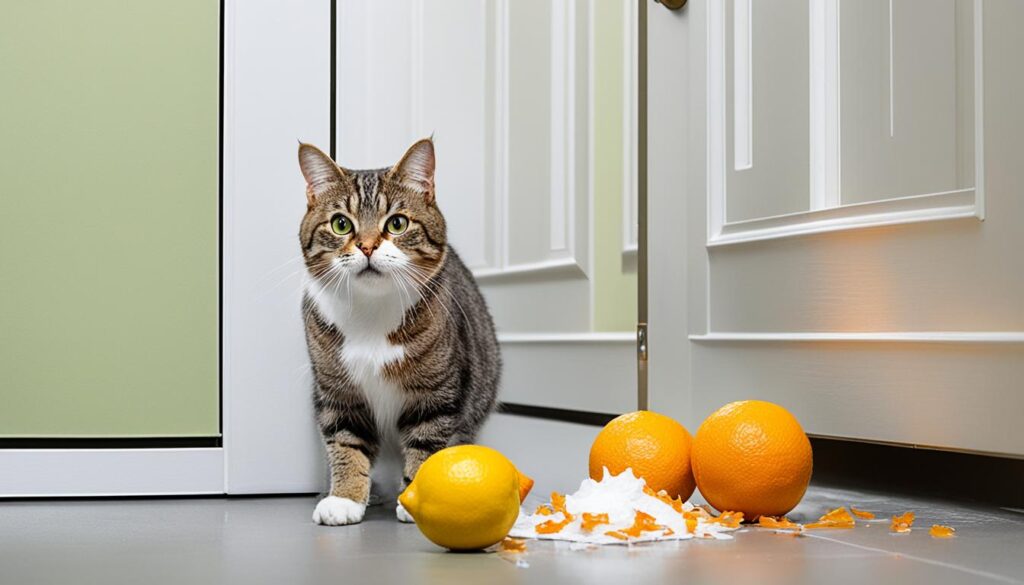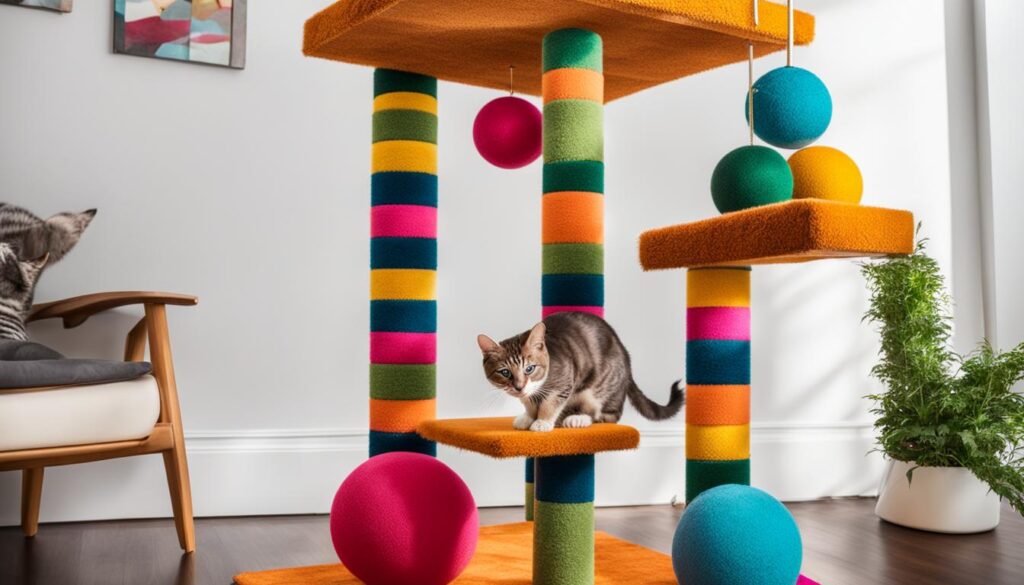How to stop cat from scratching doors?:Did you know that approximately 60% of cat owners struggle with their furry friends scratching their doors? It’s a common behavior problem that can be frustrating to deal with. Fortunately, there are several effective strategies you can implement to prevent your cat from scratching doors. In this article, I will share some quick tips on how to stop cat scratching on doors and create a more harmonious living environment for both you and your feline companion.
Key Takeaways:
- Understanding the reasons behind cat scratching on doors can help in finding the most effective solutions.
- Ignoring the scratching behavior and not reinforcing it is important in discouraging the behavior.
- Adjusting the cat’s feeding schedule can help prevent hunger-related scratching.
- Using scented repellents or double-sided tape can serve as effective deterrents.
- Trimming the cat’s nails or using nail caps can reduce the damage caused by scratching.
Understanding Why Cats Scratch Doors
When it comes to cat scratching habits, doors seem to be a favorite target for many feline friends. But have you ever wondered why cats have this peculiar behavior? Understanding the reasons behind cat scratching doors can help us find effective solutions to prevent it.
One of the main reasons for cat scratching doors is the need for attention. Cats are intelligent and social creatures, and scratching can be their way of seeking interaction and acknowledgement from their owners.
Curiosity also plays a role in their door-scratching antics. Cats are naturally inquisitive animals, and doors represent a barrier that piques their interest. Scratching at doors allows them to investigate what lies behind and satisfy their curiosity.
Cats are known for their territorial instincts, and scratching doors can be their way of marking their territory and asserting dominance. This behavior leaves behind visual and scent marks as a form of communication to other cats.
Boredom is another motivator for cats to scratch doors. When cats lack mental and physical stimulation, they may resort to destructive behaviors like scratching. Doors provide a convenient surface to indulge their need for exercise and entertainment.
Finally, cats scratch doors to maintain the health of their nails. Scratching helps to remove the old outer layers of their claws and keep them sharp and in good condition. It’s a natural grooming behavior that helps cats stay comfortable and ready for any challenges they may face.
Cat Scratching Habits
Understanding your cat’s scratching habits is crucial in addressing this behavior. Observing when your cat scratches doors and any accompanying cues can provide valuable insights into their motivation. By recognizing patterns and triggers, you can tailor your strategies to effectively redirect their scratching behavior.
| Reasons for Cat Scratching Doors | Solution |
|---|---|
| Attention-seeking | Ignore the behavior and provide alternative sources of attention. |
| Curiosity | Provide mental stimulation with interactive toys and games. |
| Territorial marking | Encourage the use of scratching posts and offer vertical territory options. |
| Boredom | Provide environmental enrichment and interactive play opportunities. |
| Nail maintenance | Offer appropriate scratching surfaces and regular nail trims. |
By addressing the underlying reasons for cat scratching doors and implementing the right strategies, you can help your furry friend break the habit and protect your doors from further damage.
Ignoring the Scratching Behavior
When a cat scratches a door to seek attention, it’s crucial not to reinforce the behavior by giving in to their demands. Ignoring the scratching and refraining from providing any response can be an effective way to discourage and extinguish the behavior over time.
In the moment, it may be challenging to resist the urge to react or scold the cat for scratching. However, any attention, whether positive or negative, can reinforce the behavior. Cats are intelligent animals and learn through associations. If they notice that scratching the door leads to attention or a response from their owners, they may continue engaging in this behavior in the future.
Instead of reacting, it’s best to stay calm and composed, as if the scratching behavior is not happening. By denying the cat the desired attention, they will eventually learn that scratching the door does not yield the desired outcome.
Remember, patience is key when it comes to modifying cat behavior. It may take time for the cat to understand that scratching the door will not bring them attention or any other desired consequence. Consistency is essential; even occasional reinforcement can hinder progress.
While ignoring the scratching behavior, it’s crucial to provide alternative options for the cat to redirect their energy and natural instincts. These alternative options will be discussed in subsequent sections.
Steps to Ignore the Scratching Behavior:
- Remain calm and composed when the cat starts scratching the door.
- Avoid reacting or scolding the cat for scratching.
- Do not provide any attention or response to the cat’s scratching behavior.
- Do not punish the cat, as this can cause fear or anxiety.
- Consistently ignore the scratching behavior in all instances.
Remember, consistency and patience are key when employing this strategy. Over time, the cat will learn that scratching the door does not lead to any desired outcome and will begin to explore alternative behaviors.
| Advantages | Disadvantages |
|---|---|
| Helps in extinguishing the scratching behavior over time. | Requires patience and consistency. |
| Prevents reinforcement of the cat’s scratching behavior. | May not result in immediate changes; progress can take time. |
Adjusting the Cat’s Feeding Schedule
If you find that your cat scratches at the door because of hunger or to request treats, adjusting their feeding schedule can help prevent this behavior. By ensuring that your cat is well-fed before closing the door for the night, you can significantly reduce the chances of hunger-related scratching.
Feeding your cat at a specific time each day and establishing a routine can help regulate their appetite and prevent them from becoming excessively hungry. Consider dividing their meals into smaller portions throughout the day to keep them satisfied.
Additionally, incorporating interactive feeding toys or puzzles can provide mental stimulation and extend the duration of mealtime, further preventing hunger-related scratching. These toys can challenge your cat’s problem-solving skills and make eating a more engaging experience.
Benefits of Adjusting the Feeding Schedule:
- Prevents hunger-related scratching behavior
- Establishes a routine for your cat’s meals
- Regulates appetite and prevents excessive hunger
- Reduces the temptation for your cat to scratch the door for food
- Provides mental stimulation through interactive feeding toys
Remember, it’s important to consult with your veterinarian to determine the appropriate feeding schedule and portion sizes for your cat’s specific needs. Every cat is unique, and their dietary requirements may vary based on factors such as age, weight, and health conditions.
By ensuring that your cat’s nutritional needs are met and adjusting their feeding schedule accordingly, you can help prevent hunger-related scratching and create a more harmonious environment for both you and your feline companion.
Using Repellents and Deterrents

When it comes to preventing cats from scratching doors, using repellents and deterrents can be an effective strategy. One option is to spray the door with a scented repellent that contains essential oils disliked by cats, such as citrus or rosemary. The strong scent will discourage them from scratching and marking their territory on the door.
Another method is to attach double-sided tape to the door. Cats don’t enjoy the sticky texture on their paws, so they will quickly learn that scratching the door is an uncomfortable experience. This will redirect their behavior to more appropriate scratching surfaces, such as scratching posts or mats.
In combination, these repellents and deterrents can provide a multi-faceted approach to discourage cats from scratching doors. By making the doors less appealing and providing alternative scratching options, you can help protect both your furniture and your doors from your feline companion’s claws.
Pros and Cons of Using Repellents and Deterrents
| Pros | Cons |
|---|---|
| Effective in deterring cats from scratching doors | May require regular reapplication of repellents |
| Non-toxic and safe for cats | Some cats may become accustomed to the repellent scent over time |
| Can be used in combination with other scratching deterrents | Double-sided tape may leave residue on the door |
Trimming the Cat’s Nails
Regularly trimming a cat’s nails is an effective way to prevent them from scratching doors to wear down their claws. By keeping their nails short, you can reduce the impact of their scratching behavior.
However, if you are uncomfortable with the nail trimming process or if your cat is resistant, seeking the assistance of a veterinarian is a good option. Vets have the experience and expertise to handle the nail trimming procedure safely and efficiently.
Alternatively, another solution to minimize door scratching is to use nail caps for cats. These caps, also known as nail covers, are small plastic caps that can be applied to your cat’s claws. Nail caps not only prevent damage to doors but also provide a safe alternative to scratching.
When using nail caps, it’s essential to choose the correct size and follow the application instructions carefully. Most nail caps last for several weeks before they need to be replaced. It’s important to monitor the caps regularly to ensure they are intact and functioning effectively.
Here is a comparison of nail trimming and nail caps:
| Nail Trimming | Nail Caps |
|---|---|
| Requires regular maintenance | Long-lasting protection |
| Reduces the risk of accidental scratches | Prevents damage to doors |
| May require assistance from a veterinarian | Easily applied at home |
Whether you choose to trim your cat’s nails or use nail caps, these methods offer an effective way to address door scratching behavior and maintain a harmonious home environment.
Providing Enrichment and Alternative Options

When it comes to redirecting your cat’s scratching behavior, providing enrichment and alternative options is key. Spending quality time with your cat, offering stimulating toys, and placing scratching posts or pads in their room can help steer them away from scratching doors. Understanding your cat’s preferences for different types of scratching surfaces can also guide you in selecting the most effective options.
Spending quality time with your cat not only strengthens your bond but also helps fulfill their need for attention and stimulation. Engage in interactive play sessions using toys that encourage natural hunting and pouncing behaviors. This not only provides an outlet for their energy but also distracts them from scratching doors.
Additionally, investing in cat toys specifically designed to satisfy their natural scratching instincts can be a great alternative. Look for toys that mimic different textures and surfaces, such as sisal or cardboard, which are commonly used in scratching posts. By providing these toys, you provide your cat with appropriate scratching options that promote healthy nail maintenance and discourage door scratching.
Scratching posts and pads are crucial in providing alternative scratching surfaces for your cat. These dedicated areas offer a satisfying texture and allow your cat to stretch and exercise their muscles. Place the posts or pads strategically near the doors they tend to scratch, making them easily accessible and encouraging their use.
Choosing the Right Scratching Post
When selecting a scratching post, consider your cat’s preferences and natural scratching habits. Some cats prefer vertical scratching surfaces, while others may prefer horizontal options. Observe your cat’s behavior to determine their preference, or experiment with different types of posts to discover what they enjoy most.
Incorporating catnip or pheromone sprays to attract your cat to the scratching posts can also enhance their interest in using them. By making the scratching posts more enticing and appealing than your doors, you’ll successfully redirect their scratching behavior and protect your home.
Remember, consistency is key in training your cat to use alternative scratching options. Encourage and reward their use of scratching posts and toys, and discourage scratching doors by using deterrents, which we discussed in an earlier section. With time and patience, your cat will learn to direct their scratching instinct towards appropriate alternatives.
Creating a Cat-Friendly Environment
Creating a dedicated space for your cat is essential to provide them with a stimulating and comfortable environment. A cat-friendly room equipped with vertical structures, windows, and cozy resting spots can help reduce their desire to scratch at doors out of boredom or territorial instincts.
Vertical Structures
Vertical structures such as cat perches and climbing trees can offer your cat an elevated vantage point where they can observe their surroundings, rest, and exercise. These structures mimic the natural environment of cats, satisfying their instinctual need to climb and explore.
Windows
Positioning cat perches or shelves near windows allows your cat to indulge in their natural curiosity by watching birds, squirrels, or other outdoor activities. The visual stimulation and connection with the outside world can help alleviate boredom and provide mental stimulation.
| Benefits of Vertical Structures and Windows |
|---|
| Provides a sense of territory and ownership |
| Offers opportunities for exercise and play |
| Reduces stress and anxiety |
| Enhances mental stimulation and prevents boredom |
Comfortable Resting Spots
Providing soft and cozy cat beds throughout the cat-friendly room ensures that your cat has comfortable resting options. Cats are known to seek out warm and snug places for relaxation, and having dedicated beds can fulfill this need. Additionally, placing the beds strategically away from doors can help discourage scratching in those areas.
With a well-designed cat-friendly room, complete with vertical structures, windows, and ample cat beds, you can create an environment that fulfills your feline friend’s natural instincts and keeps them content. This, in turn, can diminish their inclination to scratch at doors and promote harmony within your home.
Conclusion
To address the issue of cats scratching doors, it is important to understand their motivations and provide appropriate solutions. With patience and consistent effort, training a cat not to scratch doors is possible. By implementing the following strategies, you can effectively deter your cat from this behavior.
Firstly, providing alternative scratching options is essential. Cats have a natural instinct to scratch for various reasons, including stretching their muscles and maintaining their claws. By providing scratching posts, pads, or mats, you can redirect their scratching behavior to appropriate surfaces.
Additionally, reinforcing positive behaviors is crucial. Whenever your cat uses their designated scratching area instead of the door, reward them with treats, praise, or playtime. This positive reinforcement encourages them to continue using the appropriate scratching options.
Lastly, understanding the underlying motivations for door scratching can help in finding effective solutions. Whether it’s seeking attention, fulfilling curiosity, or asserting territorial instincts, addressing these underlying needs can significantly reduce their desire to scratch doors. By providing a stimulating environment, spending quality time with your cat, and ensuring their basic needs are met, you can create a cat-friendly space that minimizes their urge to scratch doors.
FAQ
Why do cats scratch doors?
How can I stop my cat from scratching the door for attention?
What can I do if my cat is scratching the door out of hunger?
Do repellents work to discourage door scratching?
How can I trim my cat’s nails to prevent scratching?
Are there alternative options for my cat to scratch besides the door?
How can I create a cat-friendly environment to discourage door scratching?
How can I train my cat not to scratch the door?
References
| International Cat Association (TICA) | https://www.tica.org/ |
| The Cat Fanciers’ Association (CFA) | https://cfa.org/ |
| World Cat Federation (WCF) | https://www.wcf-online.de/ |
| Fédération Internationale Féline (FIFe) | https://www.fifeweb.org/ |







